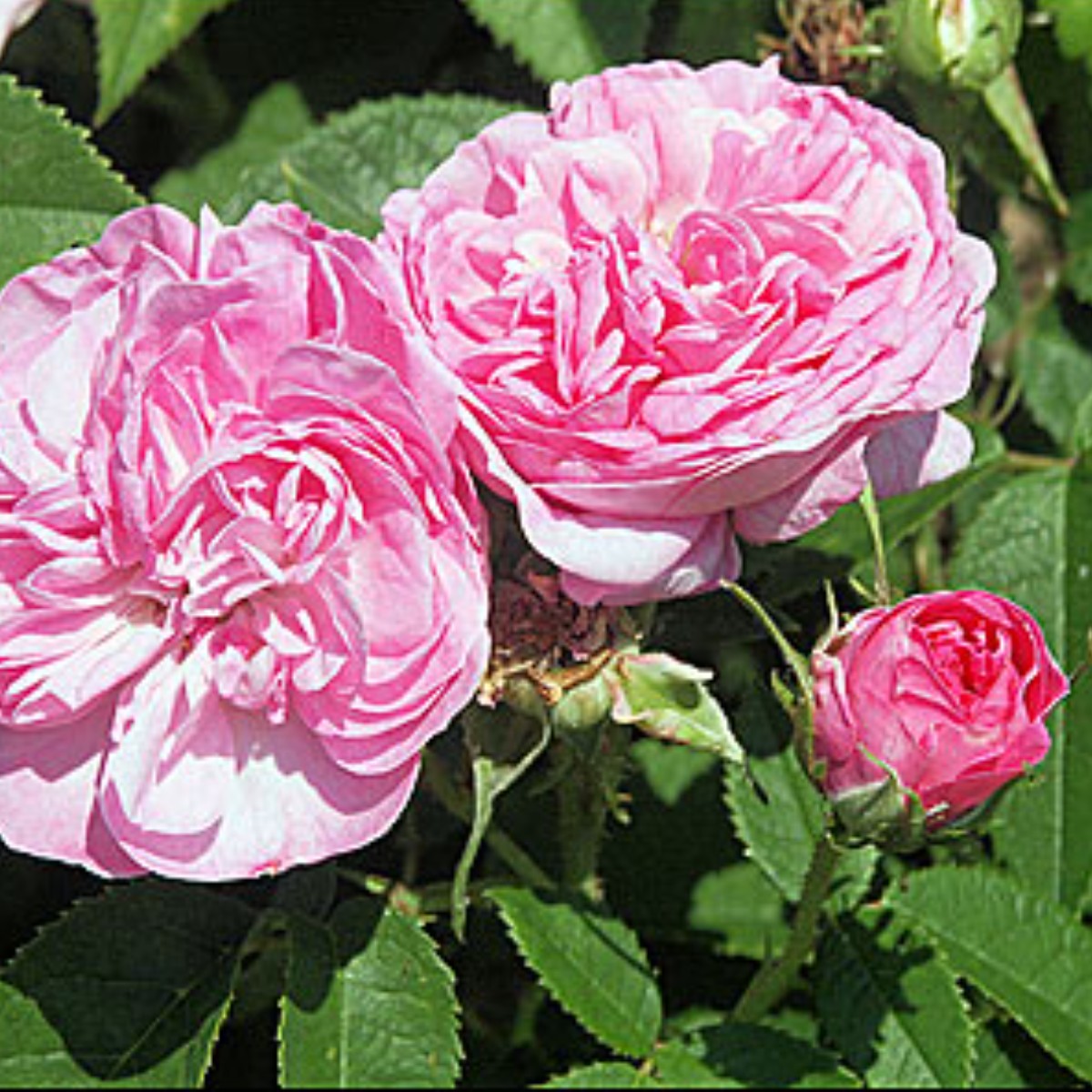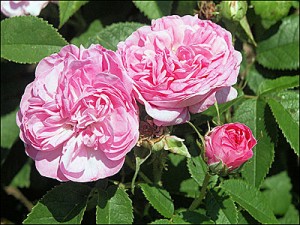Common Names: Damask rose,Damascus rose,Rose of Castile
Also referenced as: Castilian (damask), Old Castilian, Trachyean Rose, Rose of Paestum, The Alexandria Rose (damask), Semperflorens (Damask), Rosa semperflorens rubra (damask), Bifera, Rose of Castile, Rose des Quatre Saisons, Damascena bifera, Tous-les-Mois, Tous-Mois, Rosa omnium calendarum, Rosa menstrua, R. bifera, Rosa damascena var. menstrualis
Rosa Damascena is a rose hybrid derived from Rosa gallica, Rosa moschata and Rosa fedtschenkoana.
The Damask rose is a deciduous shrub growing to 2.2 metres (7 ft 3 in) tall, the stems densely armed with stout, curved prickles and stiff bristles. The leaves are pinnate, with five (rarely seven) leaflets. The roses are a light to moderate pink to light red. The relatively small flowers grow in groups. The bush has an informal shape. It is considered an important type of Old Rose, and also important for its prominent place in the pedigree of many other types.
The flowers are harvested for their fine fragrance, and are commercially harvested for rose oil used in perfumery and to make rose-water and "rose concrete". The flower petals are also sometimes used directly to flavor food or to make tea and are considered safe for human consumption.
Rosa Damascena is grown on commercial-scale to produce concentrates of the aromatic principles and is recognised as the best commercial species of the fragrant roses.
This plant contains several components such as terpenes, glycosides, flavonoids, and anthocyanins that have beneficial effects on human health. The pharmacological effects of Rosa damascene are widespread. Most of the CNS effects are hypnotic, analgesic, and anticonvulsant effects. The respiratory, cardiovascular, laxative, antidiabetic, antimicrobial, anti-HIV, anti-inflammatory, and antioxidant are other effects of this plant. It is suggested that lipid soluble (non-polar) constituents of this plant are mainly responsible for most of the above-mentioned effects.
Origin, distribution area and production: Rosa damascena is a temperate plant indigenous to Europe and Middle East countries of Iran and Turkey. It is believed that the Damask rose has originated from Damascus and introduced
in European countries.
Bulgaria, Turkey, France, Italy, Morocco, Russia and India are the main countries where it is cultivated in large-scale for the production of oil. Bulgaria, Turkey and Morocco are the largest producers of rose, oil in the world producing together 10 tonnes of oil per year. Over the last 300 years the largest integrated growing area for roses has been developed in Central Bulgaria at the foot of Balkan mountains.
Commercial Gardening:
Light: Cultivation of rose plantation should be taken up in full sunlight,, away from trees or hedges so that it gets sun shine at least during the whole forenoon. It.can be cultivated on leveled field, medium to high degree sloppy hills and terraces.
Temperature: A mild temperate climate is best" suited for Rosa Damascena. Temperature ranging from 0 to 5C for a period of about 15 days prior to start of blooming enhances the quantity as well as quality of flowers. At the time
of flowering, the temperature should be between 25 to 30C and relative humidity above 60%. High air humidity above 60% and moderate temperature of 15- 20C gives more flower yield. Rosa damascena can be cultivated even in areas with high temperatures but flower yields are very low in comparison to those plants cultivated in temperate climatic conditions.
Soil: The roses flourish well at the foot hills. It withstands wide range of soil pH conditions from 6 to 8 and silty clay loam to sandy loam soils.
Watering: Irrigation is necessary in rose plantation at the frequency of 12-15 days during peak periods. However, when plants are established properly after two years, frequency of irrigation may be reduced. Proper drainage in the field is very essential to drain out the excessive rain water from the plantations.
Feeding: The quantity of fertilizers and manures should be applied on soil test basis considering various factors like basic fertility of soil, organic content, soil texture, moisture supply, soil pH etc.
Farm yard manure@ 18-20 tonnes/hectare and 100-125 kg NPK (18:32:16) mixed fertilizer should be applied at the time of transplanting of rooted cuttings into the pits. After two years, 160-200 kg nitrogen, 60-90 kg phosphorus and 40-60 kg potash per hectare per annum are needed in Rosa damascena plantation. It is a perennial, moreover soil exhausting crop which remains in the field for more than 10 years. Therefore, split application of fertilizer doses is suggested. Fertilizer application should be completed just after pruning and before the start of monsoon or rainy season of each year.
Propagation: Rosa Damascena is propagated through one year old stem cuttings. It can also be propagated through the divisions of old plant, lateral sprouts with roots and seeds.
Stem cuttings are collected at the time of pruning in mid October to end of December; 20 cm long, 0.75-1.50 cm thick cuttings are planted in nursery; 2/3 of the stem length is inserted into soil. IB A @ 200-250 ppm is given to induce rooting. These cuttings are ready after one year for transplanting into main field.
Planting and Transplanting: Soil should be free from weeds and other vegetation. If new land is taken for cultivation, wild bushes and perennial grasses should be cleared. Drainage and irrigation channels are to be made at the same time. Proper marking of land at optimum distance is done. 1.5 x 1.5 m2 spacing is sufficient for optimum growth of plants.
Prior to transplanting in the field, the planting site is cleared of bushes etc. and pits for planting are dug at1.5 x 1.5 m2 spacing. Pits of size 45 x 45 x 45 cm3 in good soil or 60 x 60 x 60cm3 in poor soils are dug and pit soil is allowed to weather at least for one to two months before planting. The soil is refilled in the pit at the time of planting or a few days earlier to planting. Rooted stem cuttings are taken out from nursery and put in the pits. The soil is firmly pressed around the plant. While taking out plants from nursery, the lateral roots should be disturbed as little as possible. It is useful to put 3-4 kg of farm-yard manure, 20-25 gm NPK mixture {18:32:16) and 20 gm aldrin powder in the pit at the time of planting.
The best time of transplanting of rooted cuttings in the field is mid of November to mid January. The nursery plants are taken out on a cloudy day and planted in the field. Rose plants can also be transplanted in the month of rainy season.
Inter-cultural Operations: It is required to keep the plants free of weeds after planting. Usually two to three times weeding and hoeing are required to be done during the first year. Thorough weeding and circle hoeing around each plant are followed after pruning every year during winter. Two times sickling during rainy season controls the seasonal weeds and grasses in rose plantation.
Inter-cropping: There is little scope for inter-cropping or other crops in rose plantation. However, in early stage of development of new plantation, suitable inter-crops like pulses and vegetables may be taken during first two years. The rose plantation after two years develop sufficient canopy leaving no space for inter-cropping. Moreover, rose is a sunshine loving plant which prefers neat and clean area and plenty of sunshine.
Pruning: Pruning is very important operation in Rosa damascena. It requires a dormant or resting period before flowering. In temperate climatic conditions, the dormancy requirement is met naturally due to low winter temperature when plant goes under dormancy and sheds its leaves. In the ensuing springs, new shoots appear which give flower buds. In the region pf sub-tropical climate, the rose plants are essentially pruned to induce artificial dormancy. The other purposes of pruning are to train plants into desired form, to keep the desired size, to remove injured and diseased parts, to remove the terminal buds and change the growth habit to encourage bushy roses, to provide more horizontal expansion and finally production of more flower buds.
Tune, number and height of pruning are main factors for consideration. Before first flowering season of new plantation, simple tipping off (removal of terminal bud of vegetative shoots) or light pruning is sufficient in the month of December-January. During second year, plants should be pruned twice in a year, once in the month of August at 50 cm plant height and again in November-December at 75 cm plant height. Further pruning should be done only once in a year in November to December at one meter plant height. Excessive water shoots should be checked to grow, otherwise, size of bushes becomes unmanageable.
Flowering: Summer Damask rose (Rosa damascena var. trigintipetala) flowers from early March to mid of April in North Iridiru\ plains, from 10th April to 20th May in mid hills of Himachal Pradesh and early May to early June in Kashmir Valley. Exact flowering time depends upon prevailing temperature in the locality. Autumn Damask rose (Rosa damascena var. bifera) also flowers during September to November in sub-tropical plains but yield of flowers is comparatively lower than the main flowering season. Sporadic flowering may continue throughout the year in some cases. The total period of flowering is about 25-35 days but major part of the yield (about 75%) is received within 15 days of peak flowering
period.
Plucking: The .flowers are harvested in the early hours of day when they just open. Plucking starts from 4 'O' clock in early morning and continues till all flowers are plucked. Flowers are plucked by hand being nipped of just below the calyx. The work is done on payment by local villagers. On an average 2-3 kg flowers are plucked per hour manually. At the peak of the season production of flowers increases many fold and picking is continued till afternoon in order to gather all the flowers maturing on that day. The pluckers collect the flowers in cotton or polythene bags and transfer to well airy, wooden baskets.
Fresh Flowers Handling: The necessity of proper care begins with the plucking of flowers. At any stage of handling, a big heap of flowers should not be piled. Rowers collected in cotton or poly bags during plucking must be transferred into well aerated wooden baskets immediately . After harvesting, the flowers should be processed as quickly as possible to prevent fermentation. Fermented flowers lose their oil content and quality. Rowers stored for more than 12 hours lose half of the oil yield.
Summary:
Rosa Damascena
These plants require some special conditions and are unlikely to thrive without them.
CHARACTERISTICS:
Foliage: Green
Flowers: Pink. Double (17-25 petals) bloom form. Occasional repeat later in the season.
Fragrance: Strong fragrance
Shape: Bushy
Height: 120 to 150cm ( 4' to 5')
Width: 90 to 120cm (3' to 4' )
PROPER CARE:
Watering in rest period sparingly
Watering in active growth period moderately
Light full sun
Temperature in rest period min 2oC max 10oC
Temperature in active growth period min 15Cmax 30C
Humidity medium (60%)
Climate zone: 4b through 9b
Begonia propagation f...
Essential Nutrients f...
Portulacaria afra
Tillandsia recurvata
Tillandsia stricta
Columnea microphylla
Clivia miniata
Cleyera japonica
Clerodendrum thomsoni...
Cleistocactus strausi...



